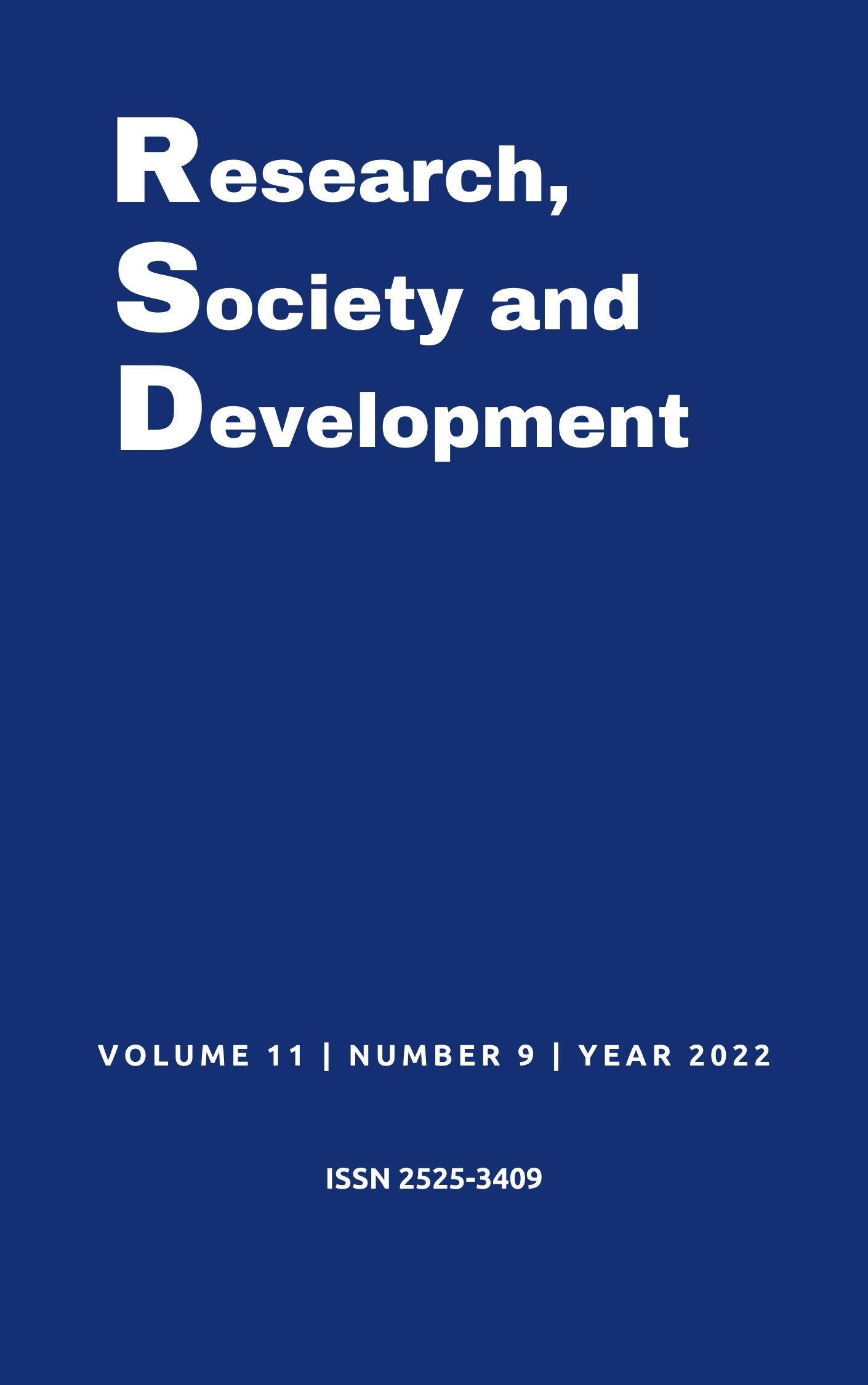Characterization of neonates affected by neonatal abstinence syndrome: An integrative review
DOI:
https://doi.org/10.33448/rsd-v11i9.31768Keywords:
Neonatal abstinence syndrome; Neonatal, pregnant women; Finnegan Scale; Neonatal abstinence syndrome characterization; Psychoactive substances.Abstract
The Neonatal Abstinence Syndrome (NAS) is defined as the situation of newborns who were exposed to different types of substances used by their mothers while pregnant, that is, still in their intrauterine phase, making them physically dependent on them, which can cause malformations and harmful effects to the nervous, gastrointestinal and respiratory systems. Objective: To characterize neonates affected by withdrawal syndrome and to list the types of psychoactive drugs that most affect them and their clinical manifestations. Methodology: Integrative review study with search in electronic databases SCIELO, PUBMED and VHL, from 2011 to 2021, without language restrictions. Results and Discussion: It was possible to identify the characteristics of newborns with substance abuse withdrawal syndrome, as well as to list the clinical manifestations that these newborns present, according to the type of substance used by the mother during pregnancy. It was also noted the importance of the multidisciplinary team when dealing with this pathology and the difficulty in making a diagnosis, since this is a subject that has not been so widely studied. Final considerations: In view of the actions analyzed, it was noted the importance of implementing strategies aimed at exploring the characteristics that these newborns present when exposed to narcotic substances during intrauterine life, thus facilitating the evaluation and early detection of this syndrome.
References
Alencar, J. C. G. et al. (2021). "Crack Babies": uma revisão sistemática dos efeitos em recém-nascidos e em crianças do uso do crack durante a gestação. Revista de Pediatria SOPERJ. 2011;12(1):16-21
Barbosa, S. M. S. et al. (2018). Repercussões Anatomofisiológicas em Recém-nascidos expostos à drogas ilícitas no período gestacional: revisão narrativa. Rev Med UFC. 58(4): 46-51.
Díaz, J. P. Z. et al. (2017). Síndrome de abstinencia neonatal: revisión de tema. Rev Pediatría. Sociedade Colombiana de Pediatría. 50(2):52-57.
Li, E. A. et al. (2018). Síndrome de abstinência neonatal: Revisão dos aspectos maternos e neonatais. VI Congresso Universitário Médico de São Camilo. Blucher Medical Proceedings. 4(1).
Luft, C. F. et al. (2019). Cuidados de enfermagem aos recém-nascidos filhos de mães que usam drogas. Rev enferm UFPE on line. 13: [1-7].
Machado, T. O. et al. (2021). Uso de drogas ilícitas na gestação: quais os malefícios à integridade do bebê? Glob Acad Nurs. 2(Spe.1):e102.
Mcqueen, K. et al. (2016). Neonatal Abstinence Syndrome. The New England Journal of Medicine. 375:2468-2479.
Paula, R. S. K. (2018). Consequências à crianças do uso de drogas durante a gestação: um artigo de revisão. Rev Med UFC. 58(1):45-52.
Pinheiro, J. M. F. et al. (2016). Atenção à criança no período neonatal: avaliação do pacto de redução da mortalidade neonatal no Rio Grande do Norte, Brasil. Ciência e Saúde Coletiva. [periódico na internet]. http://cienciaesaudecoletiva.com.br/artigos/atencao-a-crianca-no-periodo-neonatal-avaliacao-do-pacto-de-reducao-da-mortalidade-neonatal-no-rio-grande-do-norte/15162?id=15162&id=15162.
Pomar, E. G. et al. (2017). Simplification of the Finnegan Neonatal Abstinence Scoring System: retrospective study of two institutions in the USA. BMJ Open. 7(9):e016176.
Reis, F. T. et al. (2015). Repercussões neonatais decorrentes da exposição ao crack durante a gestação. Rev. Eletrônica Saúde Mental Álcool Drog (Edição Em Português), 11(4).
Ribeiro, R. A. B. et al. (2021). Abstinência Alcóolica Do Recém-Nascido: Características Físicas E Comportamentais. Glob Clin Res. 1(1):e10.
Sanlorenzo, L. A. et al. (2018). Neonatal Abstinence Syndrome: An Update. HHS Public Acess. Curr Opin Pediatr. Nashville. Abril; 30(2): 182-186.
Santillán, P. (2019). Síndrome Alcohólico Fetal. Revista Enfermería Neonatal. 29:22-28.
Souza, M. T. et al., (2010). Revisão integrativa: o que é e como fazer. Einstein, 8(1), 102-106.
Botelho, L. L. R. et al., (2011). O método da revisão integrativa nos estudos organizacionais. Gestão e Sociedade. 5(11), 121-136.
Tavella, R. A. et al (2020). Prevalence of illicit drug use during pregnancy: A global perspective. Anais da Academia Brasileira de Ciencias, 92(4), 1–18.
United Nations Office On Drugs And Crime (2019). Escritório de Ligação e Parceria no Brasil. Relatório Mundial sobre Drogas 2019: 35 milhões de pessoas em todo o mundo sofrem de transtornos por uso de drogas, enquanto apenas uma em cada sete pessoas recebe tratamento. World Drug Report.
Brasil, Ministério da Saúde. Secretaria de Atenção à Saúde. Departamento de Ações Programáticas Estratégicas. Gestação de alto risco: manual técnico. (5a ed.), Brasília, DF; 2012.
Kassanda, D. S. et al. (2013). Prevalência de Abuso de Drogas de Abuso Por Gestantes. Acta Paul Enferm. 26(5):467-71.
Downloads
Published
How to Cite
Issue
Section
License
Copyright (c) 2022 Juliana Alves Ferreira; Junior de Jesus Guimarães; Isabelle da Silva Santos Costa; Marília Pereira Dias

This work is licensed under a Creative Commons Attribution 4.0 International License.
Authors who publish with this journal agree to the following terms:
1) Authors retain copyright and grant the journal right of first publication with the work simultaneously licensed under a Creative Commons Attribution License that allows others to share the work with an acknowledgement of the work's authorship and initial publication in this journal.
2) Authors are able to enter into separate, additional contractual arrangements for the non-exclusive distribution of the journal's published version of the work (e.g., post it to an institutional repository or publish it in a book), with an acknowledgement of its initial publication in this journal.
3) Authors are permitted and encouraged to post their work online (e.g., in institutional repositories or on their website) prior to and during the submission process, as it can lead to productive exchanges, as well as earlier and greater citation of published work.

